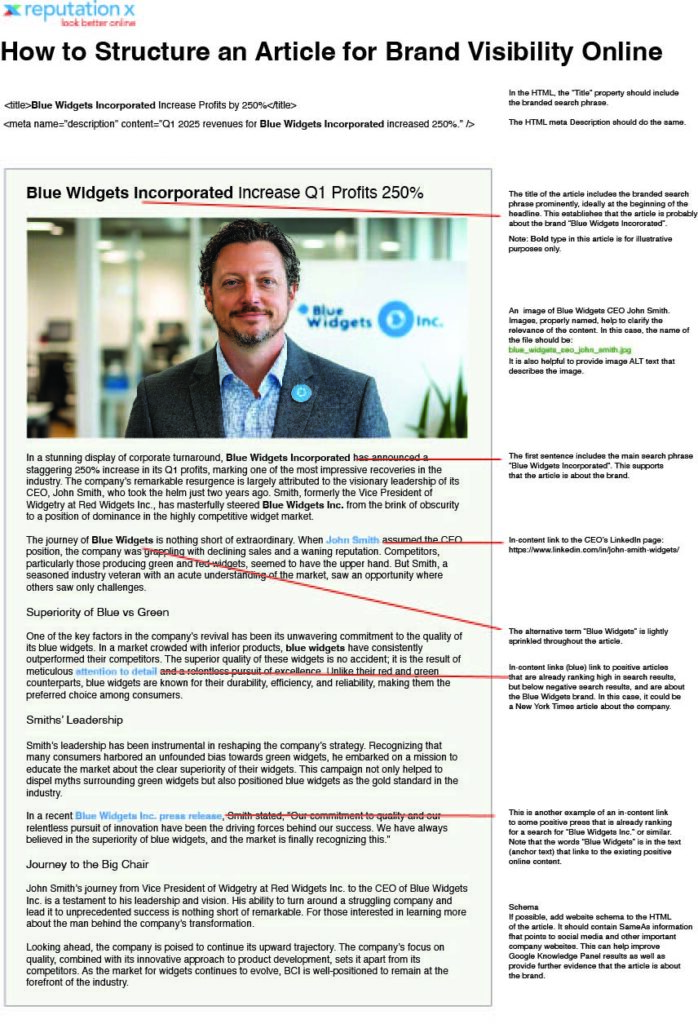When structuring an article for better online visibility, particularly for enhancing brand recognition, it’s important to focus on several key elements. These include optimizing the article for relevant branded search phrases, embedding strategic links and anchors, and ensuring the content supports positive existing online content. Below is a comprehensive guide on how to structure an article effectively for online visibility using the principles highlighted in the higher-resolution PDF you can view here.
Contents of this article
1. Start with a Strong, Relevant Title and Headline
The title of your article is one of the major components of highly visible branded online content. It should include the main branded search phrase prominently, ideally at the beginning of the headline. This helps establish the relevance of the article to the brand right from the outset.
Example:
- If the brand is “Blue Widgets Incorporated,” the title might be: “Blue Widgets Incorporated Increases Q1 Profits by 250%”.
This title immediately signals to search engines and readers that the content is directly related to the brand, improving its chances of appearing in relevant search results for the brand.
The meta description is a brief summary of your article that appears in search engine results. It should also include the branded search phrase and provide a concise overview of the article’s content. Note how, in the example below, the words “Blue Widgets” are included in the first sentence of the meta description.
Example:
- “Q1 2025 revenues for Blue Widgets Incorporated increased by 250%, marking a significant turnaround for the company.”
This description reinforces the article’s focus on the brand and can encourage clicks from search engine results pages (SERPs).
3. Use the Branded Phrase Throughout the Content
The branded search phrase should be sprinkled naturally throughout the article. This reinforces the article’s relevance to the brand without overstuffing keywords. If you can, try to include the phrase in key areas like the introduction and conclusion, as well as a few strategically placed spots in the body of the article.
Example:
- “Blue Widgets Incorporated has consistently outperformed its competitors due to the superior quality of its products.”
4. Include In-Content Links to Positive Existing Content
One of the most powerful reputation management tactics is embedding in-content links that direct readers to existing positive content about your brand. This not only passes “link juice” (SEO value) from your new article to these established pieces but also helps to boost their authority and ranking in search results.
- Anchor Text: Use the branded search phrase as the anchor text. For example, if there is a well-ranking article about “Blue Widgets” in a relevant online publication, the link in your article should look like this (using New York Times as an example): “As mentioned in this New York Times article about Blue Widgets, the company has made significant strides in innovation.”
This strategy ensures that the link is relevant and that it helps promote positive content related to your brand.
5. Use Proper Image Naming and ALT Text
Images are another element for SEO. The name of the image file and its ALT text should be descriptive, and the branded search phrase should be included when possible. This not only helps with search engine visibility but also ensures that your images are relevant to the content. Another nice thing, the image may rank for image searches on its own too.
Example:
- If your article includes an image of the CEO, the file should be named “blue_widgets_ceo_john_smith.jpg”. The ALT text might read: “John Smith, CEO of Blue Widgets Incorporated, leading the company to success.”
6. Incorporate Website Schema
Adding structured data, such as website schema, to the HTML of your article can really improve its visibility in search results. Schema markup helps search engines understand the context of your content, which can improve how it’s displayed in search results, such as in Google’s Knowledge Panel.
- SameAs Property: The schema should include “SameAs” information, which points to your brand’s social media profiles and other authoritative websites. This further strengthens the association of your content with your brand.
Example of embedded schema
Here is an example of the “person” schema that might be embedded in the HTML of the example article above if you wanted the article to focus on not only the company but also the prominently mentioned CEO. Adding schema like this does not change the article, but it does send a strong signal to search engines that the article is about the company and the CEO. This type of schema could even be combined with article schema, or many other types.
{
"@context": "https://schema.org",
"@type": "Person",
"name": "John Smith",
"jobTitle": "Chief Executive Officer",
"worksFor": {
"@type": "Organization",
"name": "Blue Widgets Inc.",
"url": "https://www.bluewidgets.com"
},
"image": "https://www.bluewidgets.com/images/john-smith.jpg",
"url": "https://www.bluewidgets.com/about-us/john-smith",
"sameAs": [
"https://www.linkedin.com/in/john-smith-widgets/",
"https://www.twitter.com/bluewidgetsinc",
"https://www.awesomebluewidgets.net"
],
"description": "John Smith is the Chief Executive Officer of Blue Widgets Inc., a leading innovator in the widget industry. He began his role as CEO two years ago, after serving as Vice President of Widgetry at Red Widgets Inc. John was awarded 'Widgeteer of the Month' in 2021 for his exceptional contributions to the field.",
"birthPlace": {
"@type": "Place",
"name": "Springfield, Illinois"
},
"alumniOf": {
"@type": "CollegeOrUniversity",
"name": "University of Widgetry",
"url": "https://www.universityofwidgetry.edu"
},
"award": "Widgeteer of the Month, 2021",
"gender": "Male",
"nationality": "American",
"email": "mailto:john.smith@bluewidgets.com",
"telephone": "+1-800-555-1234"
}
7. Links and Sharing Amplify Your Article
Once your article is published online using the SEO tactics discussed, the next critical step is to amplify its reach by strategically linking to it from your company website and other relevant websites. Links are one of the primary factors search engines use to assess the relevance and authority of online content. By generating quality backlinks, you enhance the chances of your article ranking higher in search engine results, thereby increasing its visibility to your target audience.
1. Linking from the Company Website
Your company website should serve as the central hub for all your online content. Create a prominent link to the newly published article from a relevant section of your website, such as your blog, news section, or a dedicated resource page. This not only drives direct traffic to the article but also signals to search engines that this content is valuable and directly connected to your brand.
- Internal Linking: Ensure that the article is linked from other relevant pages within your website. For example, if the article is about “Blue Widgets,” it should be linked from pages that discuss products, innovations, or case studies related to Blue Widgets. This internal linking strategy strengthens the SEO of both the article and the linked pages by distributing “link juice” across your site.
2. Linking from Other Relevant Websites
Encourage partners, industry blogs, and other authoritative websites to link to your article. Guest posts, press releases, and collaborations are excellent opportunities to generate these external links. When reputable websites link back to your content, search engines weigh your article as more credible and relevant, further boosting its visibility in search results.
- Anchor Text: When getting external links, ensure that the anchor text (the clickable text in a hyperlink) includes your branded search phrases when you can, such as “Blue Widgets Inc.” This helps reinforce the association of your article with your brand.
3. Social Media Promotion
Social media platforms like Facebook, X (formerly Twitter), LinkedIn, and others are powerful tools for promoting your article to a broader audience. Sharing your article across these platforms not only drives traffic but also creates additional signals that search engines can use to evaluate the relevance of your content.
- Multiple Postings: Don’t be shy about posting the article multiple times across your social media channels. Each post can target different aspects of the article, such as highlighting a key insight or using different media like images or videos to draw attention. Posting more than once ensures that your content reaches different segments of your audience who might not see it the first time.
- Brand-Related Hashtags: Incorporate brand-related hashtags in your posts to increase their visibility. For instance, hashtags like #BlueWidgets or #WidgetInnovation can help your content reach users interested in these topics and further establish your brand’s presence in relevant conversations.
4. Encourage Sharing
Encourage your followers and employees to share the article on their own social media profiles. The more the article is shared, the more visibility it gains, which can lead to higher engagement and more backlinks. Additionally, consider using social media advertising to boost the reach of your posts to targeted audiences.
Conclusion
Structuring an article for better online visibility involves a mix of technical SEO practices and content strategies that ensure your article is relevant, authoritative, and valuable. By following these guidelines—crafting strong titles and meta descriptions, strategically embedding in-content links, using well-named images, and incorporating schema—you can significantly enhance the online presence of your brand. This approach not only boosts visibility but also helps steer the narrative around your brand by promoting positive content and authority in search results.
Tags: Reputation Marketing.















